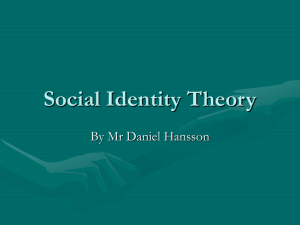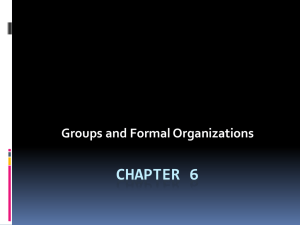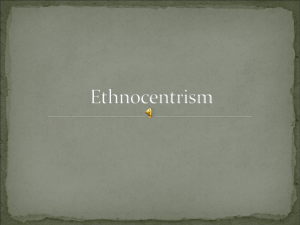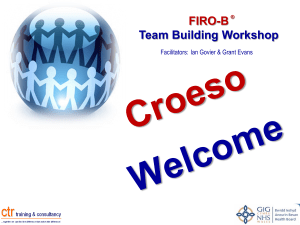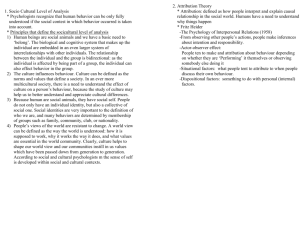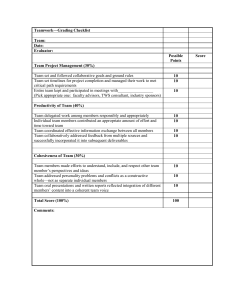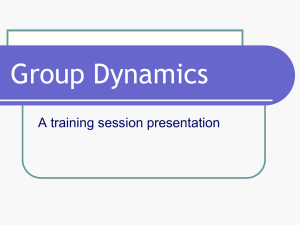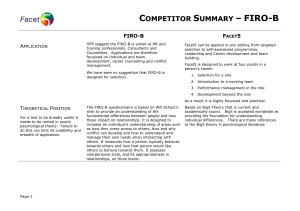Week 5 - June 7
advertisement
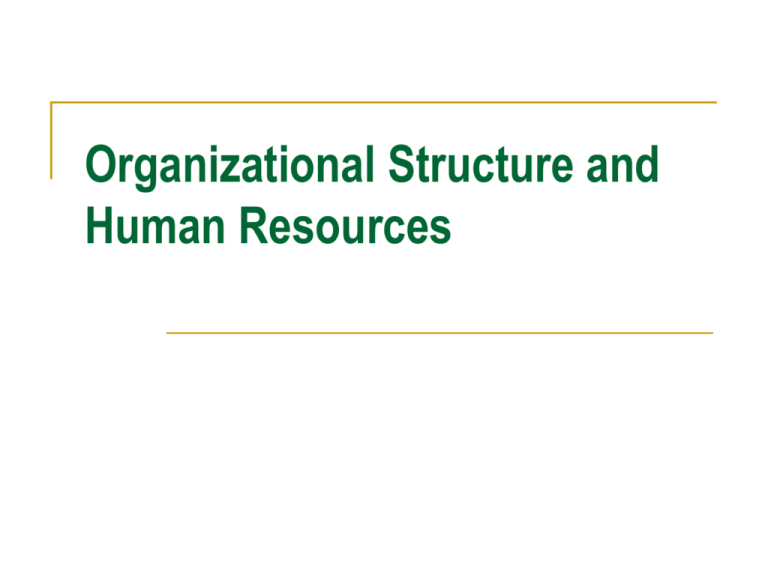
Organizational Structure and Human Resources Ages of Man Infancy Soldier (young adult Lover (teenager) Childhood Justice (accomplished adult) elderly Senility & death Why Create Structure? Organization Structure defines how job tasks are formally divided, grouped, and coordinated Work Specialization Division of labor Describes the degree to which activities in the organization are subdivided into separate jobs Departmentalization Basis by which jobs are grouped together Function Product Geography Process Customer Chain of Command Unbroken line of authority that extends from the top of the organization to the lowest echelon and clarifies who reports to whom Span of control - determines the number of levels and managers an organization has Trend in recent years has been toward larger spans of control Wide spans are consistent with efforts by companies to reduce costs, cut overhead, speed up decision making, increase flexibility, get closer to customers, and empower employees Contrasting Spans of Control Common Organizational Designs Simple structure Bureaucracy Matrix structure Simple Structure Low degree of departmentalization Wide spans of control Little formalization Difficult to maintain in anything other than small organizations Bureaucracy Highly routine operating tasks achieved through specialization Formalized rules and regulations Tasks that are grouped into functional departments Bureaucracy Centralized authority Narrow spans of control Decision making that follows the chain of command Formalization Degree to which jobs within the organization are standardized Job analysis Union Organizations – Why do unions prefer standardized jobs? Matrix Structure Combines two forms of departmentalization— functional and product Management responsibilities must be carefully agreed to. Management job descriptions must clarify responsibility Methods must be in place to establish how information will be gathered and reported. New Options The Team Structure The Virtual Organization The Boundaryless Organization <Position Title Goes Here> (Focus is on _________________) Intent: (General descripton of position The Work/Tasks: Interacts With: • Who person contacts Key Measures: • Measures • Tasks Skills/Attributes: • Experience component of job Decision Rights: • Decisions person can make alone Key Enablers: • Support required Manager, Business Administration (Focus is on Internal Business Operations) Intent: The Manager, Business Administration is responsible for ensuring the smooth operation of all internal, day-to-day aspects of Niagara Institute’s business including: finance and budgeting; invoicing and payables; facilities and supplier management; technology; contract administration; and Human Resource operations including Union relationship management. The Manager, Business Administration frees up the other functional leaders so they can focus on the work of their functions. Interacts With: The Work/Tasks: • All NI staff • Manages all aspects of the NI’s financial activities; financial analysis and tracking • Suppliers • Liaises with CBoC’s key operational departments as required: Finance, HR, Technology, etc. • CBoC counterparts • Union officials • Auditors • Taxation and other compliance officials Skills/Attributes: • Financial Management knowledge and skill • Knowledge of technology • Negotiation skills • Solid understanding of NI’s business and its critical success factors • Process improvement • Effective communicator; persuasive • Good interpersonal skills • Knowledge of HR operating practices • Excellent Administrative skills • Manages NI’s overall facilities requirements for NI’s own needs and to support program delivery • Contract Administration - Manages supplier contracts; ensures customer contract are in place to support work Key Measures: • % over or under budget (for NI’s operations) • Invoicing, receivables and payables managed within targeted time lines (cash flow management) • Employee satisfaction with: technology capability; efficiency and ease of use of internal business processes • Supplier contracts are current and competitive • Ensures appropriate HR processes are in place • Customer contracts held for all work started • Manages the Union relationship and contract negotiations • Compliance issues addressed in a timely fashion ( e.g. – up-to-date) • Ensures technology infrastructure is operational and appropriate to support business needs • Quality of union relationship; contract is current • Acts as the officer in charge for all business compliance issues Decision Rights: Key Enablers: • What is in budget or out of budget, once budget established and agreed by the Management Team • Budget required to effect changes in technology platform to support business needs • Appropriate technology to support business operations • Access to information ( from the three operating areas) • Union contract issues • Clear understanding of the boundaries within which to negotiate • Internal process changes (as relates to NI’s internal business operations – not customer processes) • Supplier contract issues (e.g. – as relates to facilities management) • Access to CBoC resources and support from them in key departments: finance, HR, technology • Client focused financial tracking system Mechanistic versus Organic Structures Strategy and Structure How do different structures produce different outcomes? Innovation Strategy Cost-Minimization Strategy Imitation Strategy Marketing/ Sales Strategy Globalization Strategy Organizational Structure and Employee Behavior Work Specialization Span of Control Centralization Job Opening and you are interviewing Use previous job description Generate one question you would ask of the interviewee Develop the kind of answer you would like to hear. Employee Selection Interview is the most widely used selection tool Results tend to have a disproportionate amount of influence on the selection decision Employee Selection The unstructured interview has been proven to be an ineffective selection device The data gathered from such interviews are typically biased and unrelated to future job performance Behavior Description Interviewing Best Predictor of Future Behavior is Past Behavior It is possible to ask questions that elicit descriptions of behavior. When asking such questions, you have to have follow ups planned but you cannot ask them in a rote manner. Inference is critical here. This is a very difficult task to do from the details. Behavior Description • Contract Administration - Manages supplier contracts; ensures customer contract are in place to support work • Can you tell me about a time when you had responsibility for managing suppliers for an organization? • What decisions could you make about suppliers? • How did your differentiate between suppliers • Did you have a difficult supplier you had to deal with? If yes, tell me about it. Written Tests Intelligence Aptitude Ability Interests Integrity Performance Simulation Tests Work samples Assessment centers Training Interpersonal Skills Diversity Training Basic Literacy Skills Problem Solving Skills Technical Skills Ethics Training Training vs Learning Formal training – What is the transfer of training? Informal training – Job shadowing, requesting help, partnering On-the-job training – A method for development while doing the work Off-the-job training – Schools, MBAs, etc. Career Development Organization’s responsibility is to build employee self-reliance and to help employees maintain their marketability through continual learning High Potentials What is a high potential? How are they identified? How are they developed? McCall – High Flyers Eleven Dimensions of Early Identification of Global Executives Seeks opportunity to learn Acts with Integrity Adapts to cultural differences Is committed to making a difference Seeks broad business knowledge Brings out the best in people Is insightful: sees things from new angles Has the courage to take risks Seeks and uses feedback Learns from mistakes Is open to criticism McCall, Morgan W. High Flyers: developing the next generation of leaders Harvard Business School Press, 1998. Organization’s Responsibility Clearly communicating the organization’s goals and future strategies Creating growth opportunities Offering financial assistance Providing the time for employees to learn Employee’s Responsibility Know yourself Manage your reputation Build and maintain network contacts Keep current Employee’s Responsibility Balance your specialist and generalist competencies Document your achievements Keep your options open Avoiding Negative Influences in Performance Appraisal Objectives employees seek are clear Criteria for measuring objectives are clear and known in advance Avoiding Negative Influences in Performance Appraisal Efforts made within employee capability are measured as satisfactory Performance as requested will lead to rewards valued by employee Criteria Evaluated Individual Task Outcomes Behaviors Traits Who Should Evaluate? Immediate Superior Peers Self-evaluation Immediate subordinates 360° feedback Performance Appraisal Methods Written Essays Critical Incidents Graphic Rating Scales Behaviorally Anchored Rating Scales Multi-person Comparisons Improving Performance Appraisals Emphasize behaviors rather than traits Document performance behaviors in a diary Improving Performance Appraisals Use multiple evaluators Evaluate selectively Train evaluators Provide employees due process Performance Feedback Manager’s reluctance Uncomfortable discussing performance weaknesses Employees become defensive Employees’ inflated assessment of own performance Training in conducting constructive feedback Team Performance Appraisals Tie the team’s results to the organization’s goals Begin with the team’s customers and associated work processes Team Performance Appraisals Measure both team and individual performance Train the team to create its own measures Performance Appraisal in Global Context Caution required in generalizing across cultures Many cultures are not particularly concerned with performance appraisal Social Identity Theory Diversity “I am ….” Please take a moment to complete this statement Do this by jotting down 10 different responses to: “I am….” Answers typically fall into 3 categories (Gordon, 1968; Rosenberg, 1979) Physical attributes, e.g., I am tall. Social identities, or formal/informal social roles, e.g., I am a son. Personal identities, or personality attributes of self, e.g., I am impatient. Social Identity Theory Key facets of Social Identity Theory (Tajfel & Turner, 1986): Recognizes the importance of categorization People have an innate and strong tendency to mentally organize things and people (including themselves) into categories To the extent that we associate ourselves with groups (i.e. categorize ourselves), we have social identities Social identities (via our group memberships) are important aspects of how we define ourselves Social Identity Theory Think about a group you belong to and with which you strongly identify Write down what that group means to you List some examples (e.g., things you’ve said or done or felt) that demonstrate that you strongly identify with that group Think about a group you belong to but with which you don’t identify Write down what that group means (or doesn’t mean) to you List some examples that demonstrate your lack of identification with that group Social Identity Theory Volunteers? Groups with which you identify… Groups with which you don’t identify… Social Identity Theory What kinds of factors influence level of identification with the group? How do you feel when someone says something negative about a group with which you strongly identify? How do you feel when the group with which you identify is associated with something bad? How do you feel when that group is associated with something good? Social Identity Theory More key facets of Social Identity Theory: Social identities also dictate our perceptions of members of our “in-groups” as… Similar to us, at least on the dimension that defines the group, and other positive attributes And yet diverse (some in-group heterogeneity) And social identities serve to distinguish us and those in our in-group from members of out-groups Personal Example Social Identity Theory Social identity influences inter-group bias and relations through the process of social comparison (Festinger, 1954) Social comparison is the evaluation of ourselves (our performance, our abilities, our appearance, etc.) in relation to others – Upward social comparison • i.e., relative to those who are “better” or “better off” • Tends to lower our self-esteem – Downward social comparison • i.e., relative to those who are “worse” or “worse off” • Tends to raise our self-esteem Social Identity Theory SI Theory extends the concept of social comparison to groups: To the extent that we identify with a group When we compare our group to “better” groups When we compare our group to “worse” groups Our group-esteem suffers, and… Consequently, our self-esteem suffers (by association) Our group-esteem improves, and… Consequently, our self-esteem improves (by association) Consequently, to the extent that we identify with groups that are valued (e.g., powerful, prestigious, high status, popular), we’ll feel good about ourselves. Social Identity Theory How social identity affects inter-group bias and relations: People are motivated to achieve high selfesteem, so how do we maximize it? Select dimensions on which to compare (those on which your in-group excels) Distort perceptions of out-groups (and in-groups)… a.k.a. stereotyping and prejudice Promote (give advantages to) your in-group… a.k.a. nepotism Hinder out-groups… a.k.a. discrimination Social Identity Theory Conclusions: Group identification is a natural consequence of our tendency to use categorization Personal self-esteem is effected by the esteem of ingroups We seek to enhance in-group esteem (and consequently self-esteem) by maximizing downward social comparisons and minimizing upward social comparisons Some ways to achieve this goal: Compare on in-group’s strongest dimensions Distort perceptions of out-groups and in-groups Promote our in-group Hinder out-groups Implications of Social Identity theory for the workplace? Diversity Diversity training: Recent survey found that 93% of companies with diversity initiatives used training as part of their programs (Robbins) Rationale for Diversity Efforts Combat negative consequences of SI Theory Expanding, diverse marketplace and pool of talent Enhance organizational performance Results? Diversity Results of private sector research indicate that the companies that have done the most to foster diversity are also the most successful companies overall. Diversity is measured as % of diversity in leadership ranks and at other levels, membership on boards of directors, spending with minority suppliers, etc. Organizational Success—Stock performance Diversity Enhanced perspectives and a wide range of points of view. Enhanced ability to target various segments of the market. Diversity programs and initiatives as the norm in many companies. Complex Relationship Between Diversity and Organizational Success Negative correlation between leadership diversity and organizational success in the short term. Difficulties associated with building consensus. Need to dismantle the existing organizational culture and create a more inclusive one in its place. Organizational performance can be hindered as organizational cultural changes. Social Identity and Diversity: Conclusion and Implications Leadership Diversity There are psychological, fundamental, practical, fiscal reasons for fostering diversity in organizations. We need to define our organizational priorities around issues of organizational success and social responsibility. Social Identity and the Global Economy: Driving need to understand and assess culture (McInerney, 1995) Etic, or universals: We all eat, we all interact with others, and we all have ways of dressing. Emic, or culture specific: What, and how, do we eat? How do we dress? How do we interact with others? “I am….a son” The importance of “Cultural syndromes" (Triandis): Shared attitudes, beliefs, norms, and values found among those who speak a particular language dialect, in a specific geographic region, during a particular historic period. Cultural syndromes provide a focus, so that we can get out of the fuzzy construct of "culture" and into a construct that we can probe systematically. Individualism vs. Collectivism (Ulaszek & Triandis study) Hofstede’s Framework for Assessing Cultures Power distance Achievement vs. nurturing Uncertainty avoidance Long-term vs. short-term orientation Vertical and horizontal cultures Individualism vs. collectivism “I am ….impatient” Personality traits are defined as "dimensions of individual differences in tendencies to show consistent patterns of thoughts, feelings, and actions" (McCrae & Costa, 1990). Examples: nervous, enthusiastic, original, accommodating, and careful Allport and Odbert (1936) identified some 4,000 trait names in the English language, and similar (although generally smaller) lists of traits have been compiled for many other languages, including Turkish and Chinese (Somer & Goldberg, 1999; Yang & Lee, 1971). FIVE FACTOR MODEL (FFM) Traits organized into five factors of Neuroticism (N), Extraversion (E), Openness to Experience (O), Agreeableness (A), and Conscientiousness (C) (FFM; McCrae & John, 1992). Individuals who are high in N are likely to be anxious, easily depressed, and irritable, vs. those who are low in N are calm, eventempered, and emotionally stable. Extraverts are lively, cheerful, and sociable; introverts are sober and taciturn. Open men and women are curious, original, and artistic; closed people are conventional and down-to-earth. Agreeableness is characterized by trust, compassion, and modesty; Conscientiousness is seen in organization, punctuality, and purposefulness. An Emic Measure The 5-Factor Model: Instrument has been translated into more than 40 languages or dialects, and studies of its factor structure have been conducted in more than 30 cultures, from Zimbabwe to Peru (McCrae & Allik, 2002). Limitations to measure Existing additional personality factors specific to individual cultures (Cheung and Leung; 1998) Factors may not all be equally important in every culture. For example, individual differences in Openness to Experience may be of little consequence in traditional cultures where life's options are severely limited (Piedmont, Bain, McCrae, & Costa, 2002). Universal Finding on Age Changes in the mean level of all five factors between adolescence and about age 30 (McCrae & Costa, 1990): N, E, and O decline, whereas A and C increase. After age 30, the same trends are seen, but at a much slower pace: In terms of personality traits, 30-year-olds resemble 70-year-olds more than 20-year-olds. Germany, Italy, Portugal, Croatia, South Korea, Estonia, Russia, Japan, Spain, Britain, Turkey, and the Czech Republic showed patterns of age differences very similar to those seen in the United States. It appears that age, especially from adolescence to midadulthood, tends to make individuals better adjusted, more altruistic, and better organized, but also less enthusiastic and less open to new experience (McCrae et al., 2000). How used in workplace? Black (2000) has shown that this 5 Factor Model is useful in police selection, adding incremental validity above and beyond cognitive testing. Police applicants in New Zealand are now routinely screened with the instrument. Groups Two or more individuals, interacting and interdependent, who come together to achieve particular objectives Formal or informal Four Types of Groups Command Task Interest Friendship Why Do People Join Groups? Basic Group Concepts Roles Norms Status Cohesiveness Size Composition Roles Psychological Contract Sets out mutual expectations Norms Acceptable standards of behavior within a group that are adopted and shared by the group’s members Examples of Cards Used in Asch Study X A B C Conformity and the Asch Studies Demonstrated that subjects conformed in about 35% of the trials Members desire to be one of the group and avoid being visibly different Members with differing opinions feel extensive pressure to align with others Symptoms of Groupthink Group members rationalize any resistance to their assumptions Members pressure any doubters to support the alternative favored by the majority Symptoms of Groupthink Doubters keep silent about misgivings and minimize their importance Group interprets members’ silence as a “yes” vote for the majority Variables Influencing Groupthink Group’s cohesiveness Leader’s behavior Insulation from outsiders Time pressures Failure to follow methodical decision-making procedures Groupshift Decision of the group reflects the dominant decision-making norm that develops during the group’s discussion Jerry Harvey’s Story What’s likely to happen? How was the decision made? Who wanted to go to Abilene? Abilene Paradox Author: Harvey, Jerry B. Title: The Abilene paradox and other meditations on management Published: Lexington, Mass. : Lexington Books ; San Diego, Calif. : University Associates, c1988. Bring Ethical Decision Making Challenge to next Class!!! Stages of Group Formation Forming Storming Norming Performing Ending Forming Creation of group Getting to know each other Developing expectations Storming Establishing boundaries Who will lead/ control How will conflicts be settled Norming Agree as a group to rules and limits Define what the task is Determine who will complete what parts Establish how influence/discipline will operate Performing All ancillary components cleared away – now can focus on the task Ending Not in every model Recognize the need to get closure when things end Use of Outside Products Tools are useful, but the way of organizing the world is the real value Self-Assessment, Organization culture and MBTI from previous classes Today FIRO-B® Other tools for decision making and change Using this approach to understand what your are dealing with is essential to developing strategic organizations. ® Overview of FIRO-B Developed by Will Schutz. Was originally created as a means to select submarine crews. Concerned about motivation to engage in social behavior. Decided that these motivations were derived from needs. Instrument owned and published by Consulting Psychologist Press. ® The FIRO-B Model Three basic interpersonal needs Need to be a part of the group – Inclusion Need to be in control of the situation and others – Control Need to be liked and feel close to others - Affection ® The FIRO-B Model Not simply the need but what you do with it. There are two types of need: Those you show to others, that can be observed by people watching you – expressed Those that you are aware of but typically do not show - Need to be in control of the situation and others – wanted ® FIRO-B Scoring Put the data into a matrix with the need across the top and the expressed vs. wanted on the side. Inclusion Control Affection expressed eI eC eA wanted wI wC wA ® FIRO-B Scoring • Low = I do this or respond this way occasionally and selectively. • Medium = I do this or respond this way usually and with many people. • High = I do this or respond this way very frequently and with almost everyone. Groups Evolve Through Particular Stages Along the Dimensions of: Inclusion — Control — Affection Inclusion — early formation stage • Where do I fit in? • Do I want to be in or out? • How committed will I become? • How committed is our leader? Control — mid-development • Competition for leadership. • What is the method for decision making? • How will power be distributed? Affection How close shall I get if the group exists over long period of time? Inclusion Forming new relations, associating with people Extent of contact and prominence a person seeks Expressed: Wanted: To what extent do I include other people in my activities (e.g., meetings, discussions) and get them to include me in theirs? Low – Quiet - Very reserved -Difficult to know How much do I want others to include me in their activities and invite me to participate? High – Engaging – Outgoing Connected High - Need for acceptance - Hate to be left out Low – Private - Little concern for popularity - Typical Behavior for: eI HIGH LOW • Initiates contact • Appears reserved • Shows interest in others • Seems restrained • Likes to socialize • Fact-oriented • Group-oriented • Doesn’t like to chit-chat • Communicative • Outgoing Typical Behavior for: wI HIGH LOW • Fears being ignored or left out • Seems self-sufficient • Likes to be included • Appears self-reliant • Is easily slighted • Likes to be alone • Wants attention • Doesn’t care to socialize • Concern for recognition • Desires status Control Decision making, influence, and persuasion between people Extent of power or dominance a person seeks Expressed: Wanted: How much control and influence do I exert over things? To what extent do I take charge and tell others what to do? How much control and influence do I want others to have over me? How comfortable am I with others telling me what to do? Low - Flexible - Little interest in power – Easygoing High - Intense –Exacting - Dominant Low – Independent - Rebellious - Prefers autonomy High - Compliant – Dependent Uncomfortable making decisions Typical Behavior for: eC HIGH LOW • Likes to direct people • Not power-oriented • Makes decisions readily • Non-directive • Organizes self and others • Prefers not to supervise others • Seems confident • Wants others to make their own decisions • Wants challenges Typical Behavior for: wC HIGH LOW • Wants direction or guidance • Appears independent • Concerned about rules • Works with, not for others • Supports others • Follows through on decisions • Cooperative • Rejects structure • Methodical and orderly • Wants structure Affection Emotional ties and warm connections between people Extent of closeness a person seeks Expressed: Wanted: To what extent do I act open, trusting, and caring toward others? How much do I want others to act open, trusting, and caring toward me? Low – Businesslike - Aloof Rational - High - Caring – Warm - Reassuring Low - Distant - Closed – Cautious High - Considerate – Approachable Sensitive Typical Behavior for: eA HIGH LOW • Open and trusting • Appears unfeeling • Warm and friendly • Seems calm and aloof • Expresses feelings • Appears objective and formal • Gives acknowledgment • Appears unemotional • Shows support • Shows encouragement Typical Behavior for: wA HIGH LOW • Wants to be liked • Appears guarded • Wants others’ trust • Not easy to know • Concern for approval • Can be direct and blunt • Responds well to praise • Seems invulnerable • Easily hurt • Appears cool and rational • Takes criticism hard The Hawthorne Studies Concluded that a worker’s behavior and sentiments were closely related Group influences were significant in affecting individual behavior. Group standards were highly effective in establishing individual worker output. Money was less a factor in determining worker output than were group standards, sentiments, and security. Cohesiveness The degree to which members of the group are attracted to each other and motivated to stay in the group Relationship of Cohesiveness to Productivity Cohesiveness High High Low Strong increase in productivity Decrease in productivity Low Moderate increase in productivity No significant effect on productivity How Can Managers Encourage Cohesiveness? Make the group smaller Encourage agreement on group goals Increase the time spent together Increase the status and perceived difficulty of group membership Stimulate competition with other groups Give rewards to the group rather than members Physically isolate the group How Size Affects a Group Smaller groups are faster at completing tasks Large groups are consistently better at problem solving Increases in group size are inversely related to individual performance
